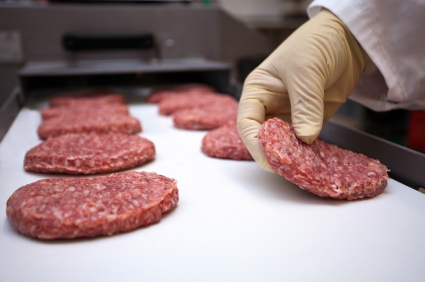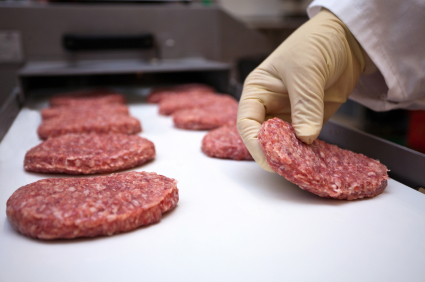In Meat Wagon, we round up the latest outrages from the meat and livestock industries.
————-
 Oh, you wanted those burgers without harmful residues! Sorry, the USDA’s meat-inspection service can’t really help you on that score. Next time you’re at an eatery whose sourcing practices you don’t trust, avoid the veal. Skip the burger, too. Those are the immediate takeaways from this stomach-turning report (PDF) from the USDA’s Office of the Inspector General. The long-term takeaways are more profound–and disturbing.
Oh, you wanted those burgers without harmful residues! Sorry, the USDA’s meat-inspection service can’t really help you on that score. Next time you’re at an eatery whose sourcing practices you don’t trust, avoid the veal. Skip the burger, too. Those are the immediate takeaways from this stomach-turning report (PDF) from the USDA’s Office of the Inspector General. The long-term takeaways are more profound–and disturbing.
The report focuses on the USDA’s system for keeping hazardous chemical residues–“veterinary drugs, pesticides, and heavy metals”– out of the meat supply. You know, meat–the stuff that Americans eat more than a half a pound of per day, on average.
How is the agency doing at this critical task? From reading the report, I’d describe its system as sieve-like–but that would be unfair to sieves. After all, those kitchen implements do at least catch most of the solid bits suspended in a liquid. The USDA routinely lets chemical residues flow right into the nation’s meat supply–without catching a damned thing.
The problem is not trivial, as the report makes clear:
Residues of drugs, pesticides, and heavy metals differ from microbiological pathogens like E. coli, Salmonella, and Listeria Monocytogenes, which the public more readily associates with food safety. While cooking meat properly can destroy these pathogens before they are consumed, no amount of cooking will destroy residues.
In fact … “In some cases, heat may actually break residues down into components that are more harmful to consumers.” [Emphasis mine.]
Evidently, the problem is worst of all for meat from animals raised on dairy farms. Such cows find their way into the beef supply in two ways. “Spent” dairy cows–ie, ones that are too sick or old to lactate–get slaughtered for beef. Their meat is so tough that it’s mainly used as hamburger. As for veal, much of the U.S. veal market is supplied by the male offspring of dairy cows. Such animals are known as “bob veal.”
According to the report, “Plants handling [spent] dairy cows and bob veal were, in 2008, responsible for over 90 percent of residue violations found.”
Now, the USDA’s meat safety arm, the FSIS, knows full well that beef-processing plants that deal with dairy cows tend have the great bulk of residue trouble. But get this, from the report:
FSIS allowed such plants to continue treating residue problems as “not reasonably likely to occur”–the determination that would allow plants to justify not implementing additional procedures to control residues.
One such plant had 211 violations in 2008, the report states–and still was able to operate as though such violations were “not reasonably likely to occur.”
Okay, so why is meat from dairy cows so likely to be tainted with residue? The report puts it bluntly:
Some producers provide antibiotics to dairy cows in order to eliminate an infection after a calf is born. If the producer perceives that the cow is not improving, he may sell the animal to a slaughter facility so that he can recoup some of his investment in the animal before it dies. If the producer does not wait long enough for the antibiotic to clear the animal’s system, some of this residue will be retained in the meat that is sold to consumers.
So let’s get this straight: sick cows pumped full of antibiotics are routinely being slaughtered for burger meat.
As for veal …
Farmers are prohibited from selling milk for human consumption from cows that have been medicated with antibiotics (as well as other drugs) until the withdrawal period is over; so instead of just disposing of this tainted milk, producers feed it to their calves. When the calves are slaughtered, the drug residue from the feed or milk remains in their meat, which is then sold to consumers.
Now do you see why I advised against ordering veal and burgers in the opening paragraph?
Recall that “spent” dairy cows were at the center of the notorious 143 million-pound beef recall back in 2008, when Humane Society investigators caught workers at a California meat plant cruelly prodding “downer” cows through a slaughter line. Long-time Meat Wagon readers will remember that, despite the recall, 37 million pounds of that suspect meat made it to school cafeterias. That’s because school cafeterias, with their tight budgets, are forced to buy the cheapest beef possible. And as we learned in the downer-cow scandal, the cheapest beef possible comes from plants that deal with spent dairy cows.
Putting everything together, this report is telling us that meat tainted with residues is routinely making it into school cafeterias.
Well, that’s the stuff I found most scandalous in this amazing report. There’s more, too. Apparently, for a lot of nasty chemical residues, the EPA has no minimum tolerance levels. And because the EPA has no minimum tolerance levels, the USDA just lets them pass right on through to the public.
And get this: when the agency positively identifies residue-tainted meat, it … does nothing about it: “We also found that FSIS does not recall meat adulterated with harmful residue, even when it is aware that the meat has failed its laboratory tests.”
To me, this report dramatizes the withering away of the federal government’s ability to protect the public from the negligence of powerful industries. Just as coal mines continue operating despite repeated safety violations, the meat industry churns out tainted product as a matter of course … with the full knowledge of government regulators. (All of this reminded me of the study a while back showing that “people who eat meat and poultry have significantly higher levels of common flame retardants compared to vegetarians.”)
The analogy between residues in meat and unsafe coal mines goes only so far, though. Every once in a while in a coal mine, a spectacular “accident” happens, drawing attention to the safety issue. For residue-tainted meat, the consequences are mainly subtle and cumulative. As the report puts it, “the effects of residue are generally chronic as opposed to acute, which means that they will occur over time, as an individual consumes small traces of the residue.” In other words, heavy eaters of industrial meat–i.e., literally hundreds of millions of Americans, many of them kids–are like the frog in the pot, not noticing that the water is slowly getting hotter and hotter.
Rest assured: the FSIS swears it will correct all the wrongs exposed in this report. But also consider this: the USDA’s Office of the Inspector General pointed out many of the same issues in a 2008 report (PDF). The FSIS swore it would make everything better then, too. The current report was explicitly written to assess the steps that have been taken since then, which doesn’t inspire confidence.
Ethanol waste as livestock feed: it breaks pigs’ hearts
Distillers grains are the the industrial waste left over from the corn-ethanol process. Used as a livestock feed–as they are, in increasing amounts–distillers grains neatly combine two of my fixations: 1) the structural public-safety and ecological problems with industrial meat production; and 2) the idiocy of committing public money to turning industrial corn into car fuel.
As I’ve shown before, distillers grains in feed rations appear to increase rates of deadly E. coli 0157 in cows. And speaking of that Inspector General’s report, they’re also full of antibiotic residues (turns out that ethanol makers use lots of antibiotics to control the fermentation process).
Well, here’s another doozy: distillers grains are being increasingly added to feed rations for hogs in CAFOs–even though they appear to make hogs sick. You see, distillers grains are often riddled with mycotoxins, micro-fungi that can be quite dangerous. Get this, from a hog-industry trade journal Pig Progress:
Incidence of Mulberry Heart Disease (MHD), a condition of the heart muscle that often leads to sudden death, has become a growing concern in the pig population. Linked to oxidative imbalance, many in the pig industry point to changes in pig rations – particularly the increased use of DDGS (Distiller’s Dried Grains with Solubles) and the threat of more concentrated levels of mycotoxins–as adding fuel to this culprit’s fire.
In fact, pig-industry folks are pretty sure that distiller grains are the problem. Get this:
Evidence can be found in examination of one such production system feeding DDGS. The system was experiencing a number of serious problems with their weaned pigs when they fed DDGS to their breeding herd. In fact, the problems had become so severe that management was going to discontinue feeding DDGS despite a savings of approximately US$0.50 per weaned pig at the time. When DDGS was removed from the ration, the problems diminished. When it was returned to the diet, the problems reappeared. DDGS levels were approximately 20% in gestation and 10% in lactation.
The article also points to research by an Ohio State professor fingering distillers grains as the culprit.
Most of us, faced with the specter of a heart condition that “that often leads to sudden death,” might consider eliminating the culprit, distillers grains, from the feed. But not industrial hog producers. Pig Progress continues
But with the economic benefits of using distillers grains for pig rations difficult to pass up [ie, they’re so damned cheap!], the days of feeding traditional corn and soy diets are unlikely to return to the extent seen in the past.
So what’s causing the problem? Evidently, distillers grains are full of “free radicals” that damage the pigs’ cells through oxidization. Pretty nasty. The article suggests supplementing pigs’ feed with the antioxidant vitamin E to help keep them alive until slaughter while chowing down on distillers grains. For me, this story represents yet another reason to avoid industrial pork.




